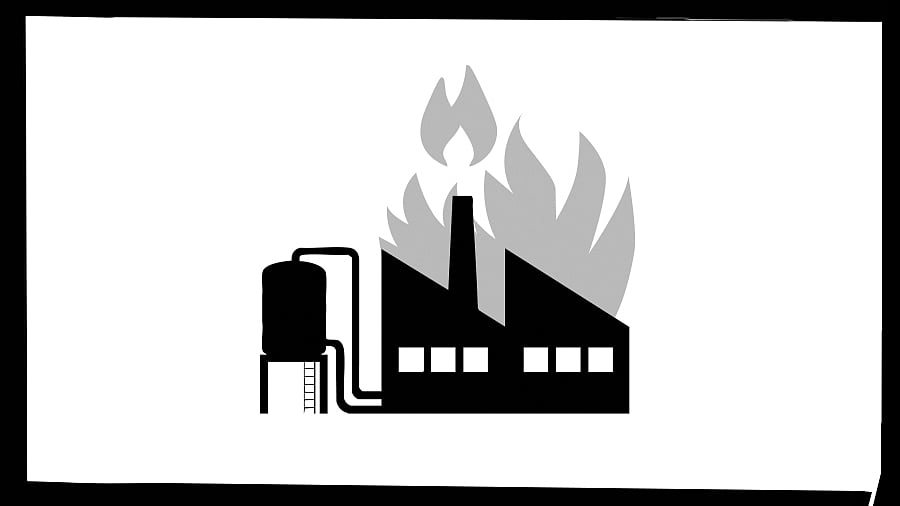
Three recent events symbolise workers’ plight due to a lack of safety at India’s workplaces. On June 30, in Telangana’s worst industrial mishap, 46 people died, eight are still in hospital, and another eight are still missing, some possibly charred beyond recognition. This human tragedy in an industrial area was caused by the explosion of a reactor in a chemical plant, heard several kilometres away. To call it an accident absolves the management of the neglect of proper maintenance or not adhering to safety protocols. In the same Sangareddy district, 25 workers died within four months in 2024. The cases of injuries or near-fatal cases that have not been reported can only be guessed. But Sangareddy is just an illustrative case, not an isolated one, across the country.
On June 7, in the Maharashtra Industrial Development Corporation (MIDC) area near Pirangut on the outskirts of Pune city, 18 workers were charred to death, 15 being women, in a deadly fire in a chemical factory. An investigation by some intrepid labour activists revealed that the workers were not even aware they were handling hazardous chemicals. They were marked by codes masking the true name of the chemicals. It was revealed that the women workers were paid less than minimum wage. The vulnerable are exploited, have job insecurity, and face the most unsafe and risky conditions. This company has been in operation since 2012, but got registered only in 2020. It also managed to obtain an ISO 9001 certification for quality management. No inspector ever visited the factory till this “accident” happened. This cannot be attributed to the ease of doing business. While EODB has shifted the onus to self-certification on the owners and managers of factories, it surely does not mean complete abdication of inspection, especially of worker safety in hazardous industries. It is made worse by the management’s greed and corner-cutting, like disabling safety sensors or running the presses at higher speeds to achieve sales targets.
The third event is the launch of a report called ‘Crushed’. This is India’s only long-running, evidence-based report published by Safe In India (SII), an NGO dedicated to improving worker safety in India’s manufacturing sector, particularly the automotive and auto-component industry, which accounts for one-third of the manufacturing sector’s GDP. SII’s work has increased worker awareness about the Employees’ State Insurance (ESI) scheme and the ESIC role. Over the past seven years, SII has helped 10,000 workers access ESIC benefits, but this still represents only 40 per cent of the victims. In the last few years, the vendors to the top ten auto brands accounted for the crushed fingers of 2,333 workers. This work breaks the silence around injuries, showing its true scale with official statistics. It also throws up laughable anomalies.
For instance, the source of data could be from two arms of the government, the labour ministry and the insurance corporation. In Haryana, routinely, the ministry reports the number of injuries around 40 to 50 per year for several years. But the ESIC claims benefits are going to nearly a thousand workers. And this is with only 40 per cent awareness among workers. It is clear that thousands of workers are getting killed or maimed across the automotive sector, and the official silence must be broken.
Thankfully, the Economic Survey of this year has highlighted the issue of workplace safety. It says that Occupational Safety and Health (OSH) regulations are not to be seen as burdensome expenses but as a strategic investment. The SII estimates that the country loses up to 4 per cent of GDP due to neglect of safety. India ranks a low 133 in global labour productivity, and this rank is directly correlated with inadequate OSH standards and poor working conditions. India’s rank is significantly below China, Vietnam, and Mexico. Investment in safety and OSH protocols not only improves the life of the worker and her family but raises productivity and morale, and improves the trust between workers and management. For the factories, it reduces absenteeism, medical expenses, and penalties for non-compliance.
Transparency and compliance
The lesson from neighbouring Bangladesh is telling. In 2013, an eight-storey building housing garment factories collapsed in the Rana Plaza, killing 1,134 people. This shocking incident led to drastic changes, including the putting in place of the Accord on Fire and Building Safety, which led to the training of 1.4 million workers. It was certainly a factor that increased Bangladesh’s garment sector competitiveness, and its exports outpaced even India and Vietnam. Even Chile and Costa Rica experienced strong labour productivity growth due to improved OSH standards and reduced occupational injuries.
The most ironic thing about the provision of workplace injury and death benefits or compensation is this. The ESI scheme was established by the ESI Act of 1948, the same year as the setting up of the National Health Scheme of the United Kingdom. Both aim to provide universal social security and healthcare (in the case of India, to workers, and in the UK, to all citizens). The present reality is that almost all UK citizens have access, and get benefits from the NHS, whereas for the ESI, many workers are not even aware of their rights and benefits. In design, the ESI is one of the world’s finest schemes, but in implementation, it falls well short.
The way forward is clear. There should be complete transparency in data reporting on accidents and fatalities, making it consistent across ESIC and the Labour Department. Compliance to safety and OSH protocols must be incentive-based. There should be a Public Private Partnership (through NGOs if necessary) to increase worker awareness about rights and safety. Top brands must be made accountable for practices in their vendors, across the supply chain.
Finally, let us note that worker safety does not merely have an instrumental value but is ultimately a moral and ethical commitment too.
(The writer is an economist; Syndicate: The Billion Press)